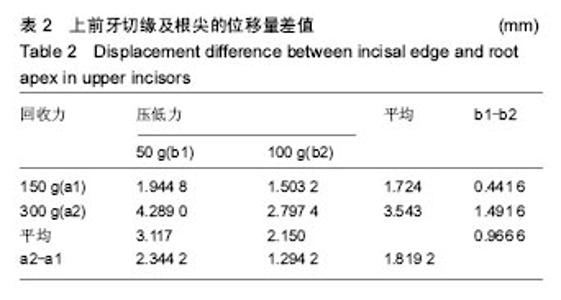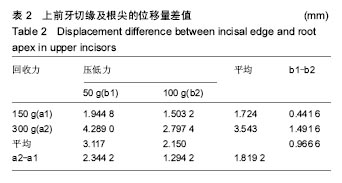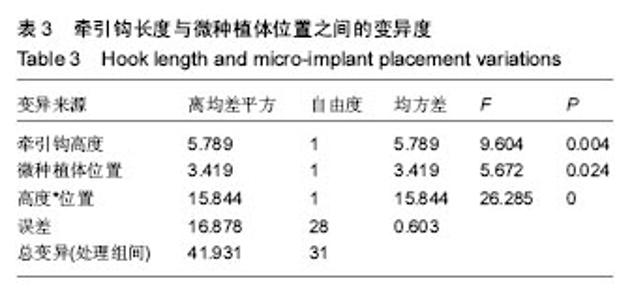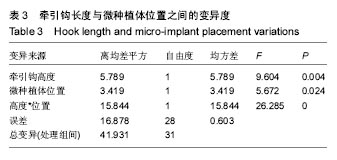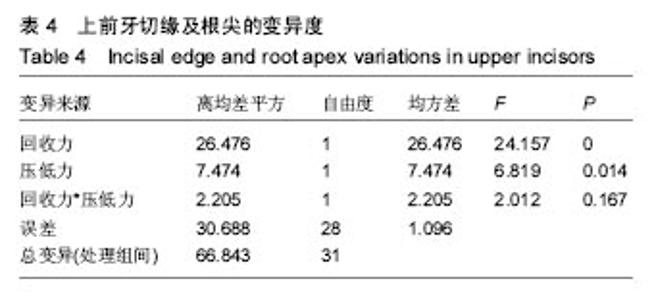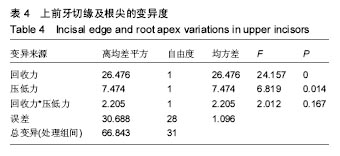Chinese Journal of Tissue Engineering Research ›› 2017, Vol. 21 ›› Issue (22): 3525-3530.doi: 10.3969/j.issn.2095-4344.2017.22.014
Previous Articles Next Articles
Anterior tooth movement of micro-implant-double slot lingual bracket system with Heat Induction Typodont System
- 1Shanxi Medical University Stomatology Hospital, Taiyuan 030001, Shanxi Province, China; 2School of Dentistry, Kyungpook National University, Daegu 427-724, Korea
-
Received:2017-06-16Online:2017-08-08Published:2017-09-01 -
Contact:Li Bing, M.D., Chief physician, Master’s supervisor, Shanxi Medical University Stomatology Hospital, Taiyuan 030001, Shanxi Province, China -
About author:Wu Xiu-ping, M.D., Associate professor, Shanxi Medical University Stomatology Hospital, Taiyuan 030001, Shanxi Province, China -
Supported by:the National Natural Science Fund of China, No. 81400553; the International Cooperation Project of Science and Technology of Shanxi Province, No. 2015081030
CLC Number:
Cite this article
Wu Xiu-ping, Hee MoonKyung, Li Bing, Jing Xuan, Li Shi-feng.
share this article
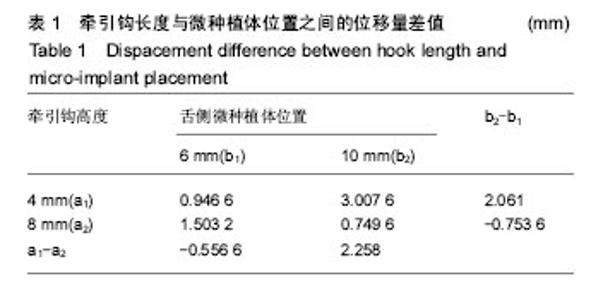
当牵引钩高度为4 mm、舌侧微种植体距牙槽嵴顶 6 mm时,前牙切缘与根尖的位移差值较小;当牵引钩高度为8 mm、舌侧微种植体距牙槽嵴顶10 mm时,前牙切缘与根尖的位移差值较小,见表1。当舌侧回收力为150 g时,前牙切缘与根尖的位移差值相对较小;唇侧压低力为100 g时,前牙切缘与根尖的位移差值相对较小,见表2。 综合6颗前牙的转矩控制情况,按照α=0.05的检验水准,根据析因设计方差分析结果显示,牵引钩高度与微种植体位置的交互作用有统计学意义(P < 0.05),需要逐一分析各因素的单独效应;回收力与压低力之间的交互作用不具有统计学意义(P > 0.05),而回收力及压低力的主效应有统计学意义(P < 0.05),见表3,4。"
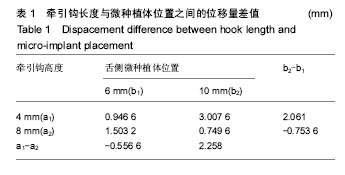
| [1]Hardwick LJ,Sayers MS,Newton JT.Patient's expectations of lingual orthodontic treatment: a qualitative study.J Orthod. 2017;44(1):21-27. [2]Auluck A.Lingual orthodontic treatment: what is the current evidence base? J Orthod.2013;40 (Suppl 1):S27-33. [3]Shetty P,Jain M,Deshpande T.Digital Technology for the Management of Impacted Canines in Lingual Orthodontics.J Clin Orthod.2016;50(11):663-672. [4]Choi S,Kim JH,Kim NJ,et al.Morphological investigation of various orthodontic lingual bracket slots using scanning electron microscopy and atomic force microscopy.Microsc Res Tech. 2016;79(12):1193-1199. [5]Knösel M,Klang E,Helms HJ,et al.Occurrence and severity of enamel decalcification adjacent to bracket bases and sub-bracket lesions during orthodontic treatment with two different lingual appliances.Eur J Orthod. 2016;38(5): 485-492. [6]袁东辉.舌侧矫治技术中的支抗控制[J].国际口腔医学杂志,2007, 34(3):180.[7]Szczupakowski A,Reimann S,Dirk C,et al.Friction behavior of self-ligating and conventional brackets with different ligature systems.J Orofac Orthop.2016;77(4):287-295. [8]Montasser MA,Keilig L,El-Bialy T,et al.Effect of archwire cross-section changes on force levels during complex tooth alignment with conventional and self-ligating brackets.Am J Orthod Dentofacial Orthop.2015;147 (4 Suppl):S101-108. [9]Reimann S,Bourauel C,Weber A,et al.Friction behavior of ceramic injection-molded (CIM) brackets.J Orofac Orthop. 2016;77(4):262-271.[10]Pauls A,Nienkemper M,Schwestka-Polly R,et al.Therapeutic accuracy of the completely customized lingual appliance WIN:A retrospective cohort study.J Orofac Orthop.2017; 78(1):52-61. [11]徐佳瑛.舌侧正畸的进展[J].口腔材料器械杂志, 2007,16(2): 86-90.[12]Knösel M,Klang E,Helms HJ,et al.Lingual orthodontic treatment duration: performance of two different completely customized multi-bracket appliances (Incognito and WIN) in groups with different treatment complexities.Head Face Med. 2014;10(1):46. [13]Hayashi K,Uechi J,Murata M,et al.Comparison of maxillary canine retraction with sliding mechanics and a retraction spring: a three-dimensional analysis based on a midpalatal orthodontic implant.Eur J Orthod.2004;26(6):585-589. [14]Facchini FM,Filho MV,Vedovello SA,et al.Wire Roughness Assessment of 0.016'' × 0.022'' the Technique Lingual Orthodontics.J Contemp Dent Pract.2017;18(4):295-299.[15]Barak S,Neuman M,Iezzi G,et al.A new device for improving dental implants anchorage: a histological and micro-computed tomography study in the rabbit.Clin Oral Implants Res.2016;27(8):935-942. [16]MacGinnis M,Chu H,Youssef G,et al.The effects of micro-implant assisted rapid palatal expansion (MARPE) on the nasomaxillary complex--a finite element method (FEM) analysis.Prog Orthod. 2014;29(15):52. [17]梁炜,林久祥,徐宝华,等.唇、舌侧正畸中上颌中切牙转动中心的研究[J].口腔正畸学,2008,15(3):121-123.[18]Kumar A,Khanam A,Ghafoor H.Effects of intraoral aging of arch-wires on frictional forces: An ex vivo study.J Orthod Sci.2016;5(4):109-116.[19][19]Humayun N,Kolhatkar S,Souiyas J,et al.Mucosal coronally positioned flap for the management of excessive gingival display in the presence of hypermobility of the upper lip and vertical maxillary excess: a case report.J Periodontol. 2010;81(12):1858-1863.[20]Hong RK,Lim SM,Heo JM,et al.Treatment of bimaxillary protrusion with lever-arm mechanics and micro-implant anchorage.J Clin Orthod.2014;48(8):505-512. [21]刘小东.个体化舌侧矫治微种植体支抗整体远移上颌牙列的三维有限元研究[D].郑州:郑州大学,2016.[22]Kojima Y,Kawamura J,Fukui H,Finite element analysis of the effect of force directions on tooth movement in extraction space closure with miniscrew sliding mechanics.Am J Orthod Dentofacial Orthop. 2012;142(4):501-508. [23]Knösel M,Klang E,Helms HJ,et al.Completely customized lingual appliances reduce the risk of enamel decalcification many times over.Inf Orthod Kieferorthop.2015;47(1):149-157.[24]Papadogiannis D,Iliadi A,Bradley TG,et al.Viscoelastic properties of orthodontic adhesives used for lingual fixed retainer bonding.Dent Mater.2017;33(1):e22-e27. [25]Wiechmann D,Klang E,Helms HJ,et al.Lingual appliances reduce the incidence of white spot lesions during orthodontic multibracket treatment.Am J Orthod Dentofac Orthop.2015; 148(3):414-422. [26]Kalarickal B.Group Distal Movement of Teeth using Micro-Screw-Implant Anchorage-A Case Report.J Clin Diagn Res.2014;8(5):ZD26-29. [27]El-Wassefy N,El-Fallal A,Taha M.Effect of different sterilization modes on the surface morphology, ion release, and bone reaction of retrieved micro-implants.Angle Orthod. 2015;85(1):39-47. [28]卢红飞, 麦志辉, 陈奇,等.不同加载方式压低上前牙时初始应力在牙体牙周膜及牙槽骨分布的三维有限元分析[J].中国组织工程研究与临床康复,2011,15(48):8964-8967.[29]Samuels RH,Rudge SJ,Mair LH.A clinical study of space closure with nickel-titanium closed coil springs and an elastic module.Am J Orthod Dentofacial Orthop.1998;114(1): 73-79. [30]Papageorgiou SN,Gölz L,Jäger A,et al.Lingual vs. labial fixed orthodontic appliances: systematic review and meta-analysis of treatment effects.Eur J Oral Sci.2016;124(2):105-118. [31]Mathew RN,Katyal A,Shetty A,et al.Effect of increasing the vertical intrusive force to obtain torque control in lingual orthodontics: A three-dimensional finite element method study.Indian J Dent Res.2016;27(2):163-167.[32]Abellán R, Gómez C, Oteo MD, et al. Short- and Medium-Term Effects of Low-Level Laser Therapy on Periodontal Status in Lingual Orthodontic Patients.Photomed Laser Surg.2016;34(7):284-290. [33]Afrashtehfar KI.Evidence regarding lingual fixed orthodontic appliances' therapeutic and adverse effects is insufficient.Evid Based Dent.2016;17(2):54-55.[34]方志欣,周嫣,陈世稳,等.简易个性化唇舌侧矫治技术Typodont模型的制作[J].中国美容医学,2015,24(23):65-67.[35]Kyung HM,Kim JK,Kyung IK.Heat Induction Typodont System(HITS) for simulating orthodontic tooth movement.Clin J Korean Assoc Orthod.2013;3(5):177-179.[36]Sung JW,Kwon TY,Kyung HM .Debonding forces of three different customized bases of a lingual bracket system. Korean J Orthod.2013;43(5):235-241.[37]Kim CS,Lee SC,Kyung HM,et al.Stability of mandibular setback surgery with and without presurgical orthodontics.J Oral Maxillofac Surg.2014;72(4):779-787. |
| [1] | Wei Guoqiang, Li Yunfeng, Wang Yi, Niu Xiaofen, Che Lifang, Wang Haiyan, Li Zhijun, Shi Guopeng, Bai Ling, Mo Kai, Zhang Chenchen, Xu Yangyang, Li Xiaohe. Biomechanical analysis of non-uniform material femur under different loads [J]. Chinese Journal of Tissue Engineering Research, 2022, 26(9): 1318-1322. |
| [2] | Zhang Yufang, Lü Meng, Mei Zhao. Construction and verification of a full spine biomechanical model of adolescent scoliosis [J]. Chinese Journal of Tissue Engineering Research, 2022, 26(9): 1351-1356. |
| [3] | Zhang Jichao, Dong Yuefu, Mou Zhifang, Zhang Zhen, Li Bingyan, Xu Xiangjun, Li Jiayi, Ren Meng, Dong Wanpeng. Finite element analysis of biomechanical changes in the osteoarthritis knee joint in different gait flexion angles [J]. Chinese Journal of Tissue Engineering Research, 2022, 26(9): 1357-1361. |
| [4] | Yao Xiaoling, Peng Jiancheng, Xu Yuerong, Yang Zhidong, Zhang Shuncong. Variable-angle zero-notch anterior interbody fusion system in the treatment of cervical spondylotic myelopathy: 30-month follow-up [J]. Chinese Journal of Tissue Engineering Research, 2022, 26(9): 1377-1382. |
| [5] | An Weizheng, He Xiao, Ren Shuai, Liu Jianyu. Potential of muscle-derived stem cells in peripheral nerve regeneration [J]. Chinese Journal of Tissue Engineering Research, 2022, 26(7): 1130-1136. |
| [6] | Zhang Jinglin, Leng Min, Zhu Boheng, Wang Hong. Mechanism and application of stem cell-derived exosomes in promoting diabetic wound healing [J]. Chinese Journal of Tissue Engineering Research, 2022, 26(7): 1113-1118. |
| [7] | Wen Mingtao, Liang Xuezhen, Li Jiacheng, Xu Bo, Li Gang. Mechanical stability of Sanders II type calcaneal fractures fixed by two internal fixation methods [J]. Chinese Journal of Tissue Engineering Research, 2022, 26(6): 838-842. |
| [8] | Wang Hailong, Li Long, Maihemuti·Yakufu, Chen Hongtao, Liu Xu, Yilihamu·Tuoheti. Finite element analysis of stress distribution of acetabular prosthesis in the Lewinnek safety zone [J]. Chinese Journal of Tissue Engineering Research, 2022, 26(6): 843-847. |
| [9] | Wei Bing, Chang Shan. Finite element analysis of different angles of nail placement in sagittal plane of spinal fracture [J]. Chinese Journal of Tissue Engineering Research, 2022, 26(6): 864-869. |
| [10] | Li Guijun, Fang Xiaohui, Kong Weifeng, Yuan Xiaoqing, Jin Rongzhong, Yang Jun. Finite element analysis of the treatment of hallux valgus deformity by microplate combined with super strong suture elastic fixation [J]. Chinese Journal of Tissue Engineering Research, 2022, 26(6): 938-942. |
| [11] | He Yunying, Li Lingjie, Zhang Shuqi, Li Yuzhou, Yang Sheng, Ji Ping. Method of constructing cell spheroids based on agarose and polyacrylic molds [J]. Chinese Journal of Tissue Engineering Research, 2022, 26(4): 553-559. |
| [12] | He Guanyu, Xu Baoshan, Du Lilong, Zhang Tongxing, Huo Zhenxin, Shen Li. Biomimetic orientated microchannel annulus fibrosus scaffold constructed by silk fibroin [J]. Chinese Journal of Tissue Engineering Research, 2022, 26(4): 560-566. |
| [13] | Baibujiafu·Yelisi, Renaguli·Maihemuti, Aizimaitijiang·Saiyiti, Wang Junxiang, Nijiati·Tuerxun. Stress analysis of maxillary central incisor crown implant restoration in different occlusal modes [J]. Chinese Journal of Tissue Engineering Research, 2022, 26(4): 567-572. |
| [14] | Wang Can, Gu Weiping, Jiang Yubin, Zhu Lin, Chen Gang. Finite element analysis of the influence of different implant designs on the stress of mandibular edentulous jaw [J]. Chinese Journal of Tissue Engineering Research, 2022, 26(4): 573-578. |
| [15] | Zhang Jianguo, Chen Chen, Hu Fengling, Huang Daoyu, Song Liang. Design and biomechanical properties of dental implant pore structure based on three-dimensional finite element analysis [J]. Chinese Journal of Tissue Engineering Research, 2022, 26(4): 585-590. |
| Viewed | ||||||
|
Full text |
|
|||||
|
Abstract |
|
|||||
